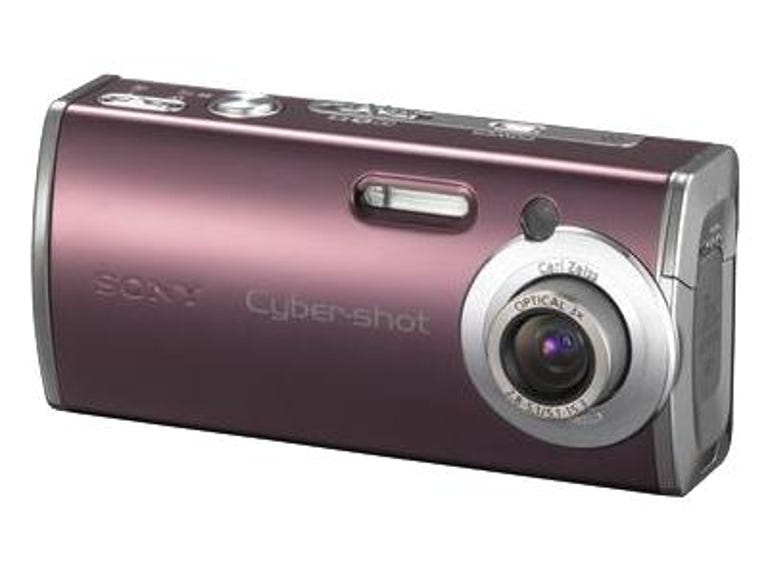 Why You Can Trust CNET
Why You Can Trust CNET Sony Cyber Shot L review: Sony Cyber Shot L
A stylish pocket camera with quick performance but subpar photo quality.
Casual photographers will like the compact design, above-average performance, and long battery life of Sony's Cyber Shot DSC-L1, along with the extrawide view offered by its 32mm-to-96mm (35mm-camera equivalent) 3X Carl Zeiss zoom lens. However, mediocre image quality, a tiny 1.5-inch LCD viewfinder that's difficult to use, and a lack of even basic manual-exposure controls other than exposure compensation put this pocketable camera securely in the nonenthusiast snapshooting camp.
About the size and shape of a Three Musketeers bar at 3.7 by 1.7 by 1.1 inches, the 5.5-ounce Cyber Shot DSC-L1 fits in any pocket. If you want to use a tripod--which is unlikely if you're considering this camera--you'll also need to carry its separate tripod mount adapter. Ergonomically, the camera is laid out well for either one- or two-handed shooting, although we wish the three-position mode switch on top had the still-recording function at the far right where the Movie mode resides rather than in the center position. When we were in a hurry, it was too easy to accidentally switch from Review to Movies.
The Good
The Bad
The Bottom Line
The top panel is also home to the DSC-L1's built-in microphone, a recessed on/off button with embedded green LED power light, a zoom rocker, and a shutter-release button. On the uncluttered back panel you'll find a speaker, a flash-ready/battery-charging indicator light, three control keys, and a four-way joy-button that truly is a joy to use. When navigating this Sony's menus, you simply rock the button in any of four directions to zip through the choices, then press it to make your selection. In shooting mode, the joy-button sets flash options (up), activates the self timer (down), flips between spot and multipattern metering (right), and reviews the last photo (left).
Three buttons arrayed below the 1.5-inch LCD set image quality or delete a photo; switch among info-display options, which include a live histogram; and summon the well-laid-out menus. The DSC-L1 remembers your last menu selection, so if you're frequently adjusting exposure on the fly (plus or minus 2EV in 1/3EV steps), pressing the menu key brings up the exposure compensation menu.
The LCD viewfinder proved a disappointment. Rather coarse with only 78,000 pixels on display, it seemed even smaller than its advertised 1.5-inch-diagonal dimensions, particularly when this non-bifocal-wearing reviewer tried to read the tiny text of the onscreen information display. Even with the brightness ratcheted all the way up, the LCD was difficult to view in direct sunlight. There's no optical viewfinder alternative, so when outdoors, you may find yourself using a hand as a sunshade more than you'd like. Ghosting wasn't excessive, but the LCD did blank out in burst mode, making it difficult to follow moving subjects.
This Sony insists on making most of the decisions for you, as there is no manual control of f-stops or shutter speed and only seven scene modes to choose from, including Twilight, Twilight Portrait, Landscape, Soft Snap (for pleasantly blurred portraits), both Snow and Beach modes, and a slow-speed Candlelight option. Notably absent is a sports mode to take advantage of the DSC-L1's 1/2,000-second top shutter speed, which slows down to as long as 1/8 second in low light. You can choose between multipattern and spot metering and change ISO manually to ISO 100, ISO 200, or ISO 400 settings.
No separate macro mode is required, as the five-area multipoint autofocus/center autofocus system works well down to 4.72 inches. Both continuous autofocus and single autofocus modes are available.
Performance figures for the Sony were generally excellent, except for an anemic flash, which reaches out no farther than six feet, and severe shutter lag (2.3 seconds) under low-contrast lighting, even with the high-output, red autofocus illuminator blazing. However, an almost imperceptible 0.4-second shutter delay under high-contrast lighting and 1.7-second shot-to-shot times (2.4 seconds with flash) may make the DSC-L1 your favorite camera for spur-of-the moment photos. You won't wait long for this camera to wake up, either, with its 3.3-second time-to-first-shot benchmark.
A zippy burst mode produced 4 full-resolution pictures in less than 3 seconds, and 30 VGA-sized photos in 26 seconds. We got 696 pictures from the lithium-ion rechargeable battery, half of them with flash as well as lots of zooming, picture-review, and other power-eating activities.
The DSC-L1's biggest weakness is in picture quality. Images were soft and lacking in detail for a 4-megapixel camera, with a lot of the detail masked by plentiful JPEG artifacts, even at the best Fine compression ratio. Colors, particularly flesh tones, often had a yellow cast. Blown-out highlights and chromatic aberrations such as purple fringing abounded, too, and some noise was visible even at ISO 100, increasing to a lot of noise at higher sensitivities. The red-eye preflash seemed to have no effect on the amount of red-eye produced. You'll probably be happy with the Sony's image quality only at smaller print sizes and for Web display.
